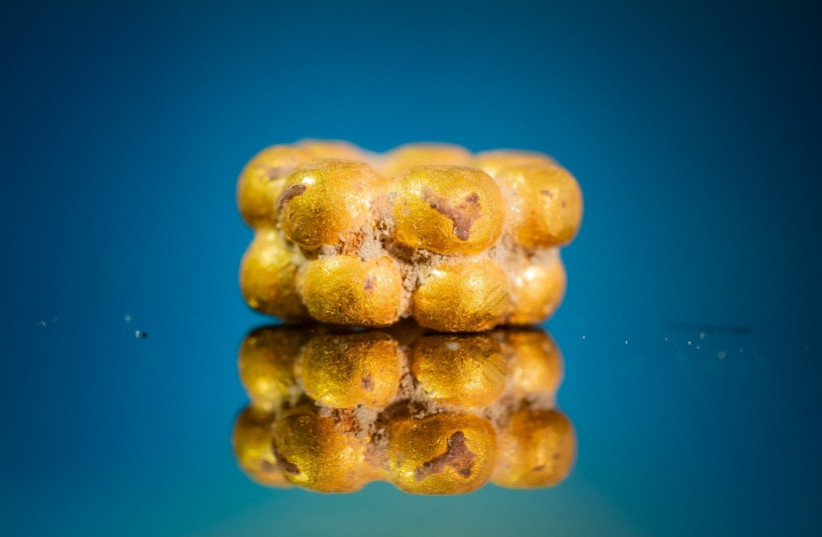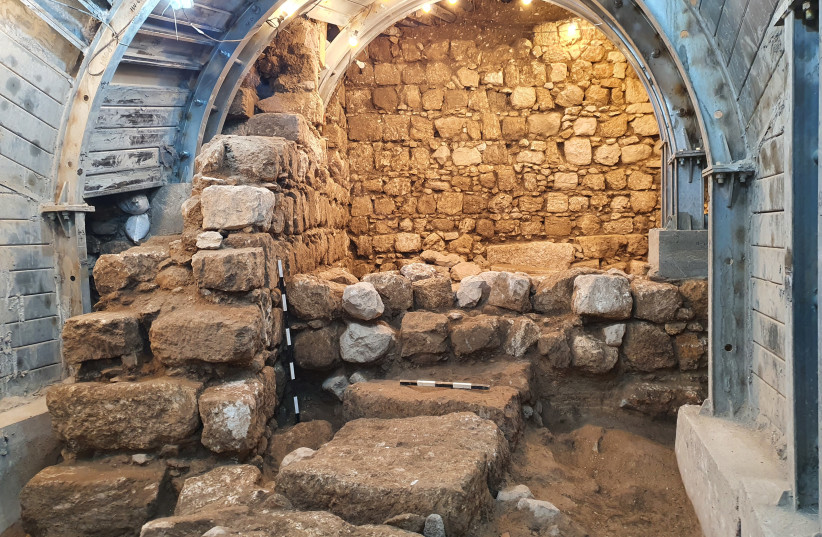A unique bead made from pure gold was uncovered during a sifting project at the Archaeological Experience in the Emek Tzurim National Park, the Antiquities Authority announced Wednesday. It was dated to at least 1,600 years ago, which was the end of the Roman era in Israel.
The bead was found in dirt that was removed from a grandiose Roman structure discovered in the Pilgrimage Road Excavation. It was created using a unique technique that required delicate workmanship to affix tens of tiny balls together in the shape of a ring in order to create one small bead.
Gold items are a rare find
The find holds unique importance due to the general lack of gold items found in archaeological excavations and because the unique and complex technique used to create them made beads of this style uncommon. The technique most probably originates from Mesopotamia, where it was known approximately 4,500 years ago.
Eighteen-year-old Hallel Feidman from Bnei Ayish, a national service volunteer, found the gold bead.
“I poured the pail onto the sieve and began to wash the material that was brought from the excavations in the City of David, “ Feidman said, describing the moment she made the discovery. “And then I saw something shiny in the corner of the sieve – different – that I don’t normally see. I immediately approached the archaeologist and he confirmed that I found a gold bead. Everyone here was very excited.“
Amir Golani, an ancient jewelry expert at the Antiquities Authority, said “Throughout all my years in archaeology, I have found gold perhaps once or twice – so to find gold jewelry is something very, very special.”
He pointed out that the bead, which survived unscathed, is probably only a small part of a necklace or bracelet that included additional beads. “Whoever could afford a piece like this made from gold was an affluent person with means.”
The most interesting aspect of the bead is its “unique and complex production method,” explained Golani. “A good understanding of the materials and their properties is required, as well as control over the heat, in order to on the one hand solder the tiny balls together to create a tiny ring, while also preventing overheating which may lead all the gold to melt.
“Only a professional craftsman could produce such a bead, which is another reason that this find holds great value,” Golani said.
The use of a unique production technique from outside of Israel, coupled with the use of gold in creating this bead, speaks to the wealth of its owner. It is possible that the bead was created in a different area and made its way to the City of David due to the extensive trade relations between Jerusalem and other regions at that time.
Another theory is that the bead was a gift sent to a Jerusalem resident, or that possibly due to its unique nature, the bead was passed within the family from one generation to another as an inheritance.
According to Shlomo Greenberg and Ari Levy, excavation directors on behalf of the authority, “The bead originated in a grandiose structure which is at least 25 meters long. The structure was built on the Pilgrimage Road in the City of David, in a building style that characterizes upscale buildings. The wealth of the building’s occupants is evidenced by additional finds that were discovered in it, like imported clay vessels and a decorated mosaic floor.”
The archaeologists explained that it is possible that the bead was created in a period that precedes the building of the structure in which it was found, however, it is reasonable to assume that the people that lived in the structure used the bead which may have accidentally been lost when the necklace broke.
A number of similar silver beads dating to the end of the First Temple period 2,500 years ago were found in burial caves during excavations carried out by Prof. Gabriel Barkay in Ketef Hinnom, not far from the City of David. Until today, only a few dozen golden beads have been found in Israel.
The Emek Tzurim National Park operates all year long, and over the years has uncovered numerous finds from different periods in Jerusalem’s history, including rare jewelry, coins and pottery fragments.
Eli Escusido, director of the Antiquities Authority, added that “Although it is a tiny find, it is precisely the personal, day-to-day items that manage to touch and connect us more than anything else, directly, to a certain person. Even with today’s advanced technology, creating something like this would be very complex. A close examination of this object fills one with a deep sense of admiration for the technical skill and ability of those who came before us many centuries ago.”


